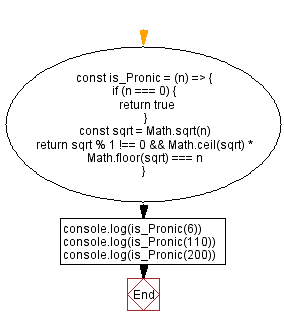JavaScript: Pronic number
JavaScript Math: Exercise-72 with Solution
Check Pronic Number
Write a JavaScript program to check if a given number is pronic using the product of two consecutive numbers. If the number is pronic return true otherwise false.
From Wikipedia –
A pronic number is a number that is the product of two consecutive integers, that is, a number of the form n(n+1). The study of these numbers dates back to Aristotle. They are also called oblong numbers, heteromecic numbers, or rectangular numbers; however, the term "rectangular number" has also been applied to the composite numbers.
The first few pronic numbers are:
0, 2, 6, 12, 20, 30, 42, 56, 72, 90, 110, 132, 156, 182, 210, 240, 272, 306, 342, 380, 420, 462 ...
Sample Data:
6 -> true
110 -> true
200 -> false
Sample Solution:
JavaScript Code:
/**
* Checks if a given number is a pronic number.
* @param {number} n - The number to check.
* @returns {boolean} - True if the number is pronic, false otherwise.
*/
const is_Pronic = (n) => {
// Check if the number is 0 (0 is considered a pronic number)
if (n === 0) {
return true;
}
// Calculate the square root of the number
const sqrt = Math.sqrt(n);
// Check if the square root is not an integer and the product of the ceiling and floor of the square root is equal to the number
return sqrt % 1 !== 0 && Math.ceil(sqrt) * Math.floor(sqrt) === n;
};
// Test the function with different numbers
console.log(is_Pronic(6)); // Output: true
console.log(is_Pronic(110)); // Output: true
console.log(is_Pronic(200)); // Output: false
Output:
true true false
Flowchart:

Live Demo:
See the Pen javascript-math-exercise-72 by w3resource (@w3resource) on CodePen.
For more Practice: Solve these Related Problems:
- Write a JavaScript function that checks if a given number can be expressed as n*(n+1) for some integer n.
- Write a JavaScript function that iterates through potential factors to determine if the product of two consecutive integers equals the given number.
- Write a JavaScript function that validates the input and returns a boolean indicating whether the number is pronic.
- Write a JavaScript function that calculates candidate values for n and verifies if n*(n+1) matches the input number.
Go to:
PREV : Prime Factors of a Number.
NEXT : Express as Sum of Consecutive Integers.
Improve this sample solution and post your code through Disqus.
What is the difficulty level of this exercise?
Test your Programming skills with w3resource's quiz.
